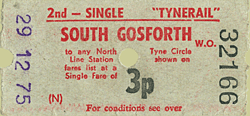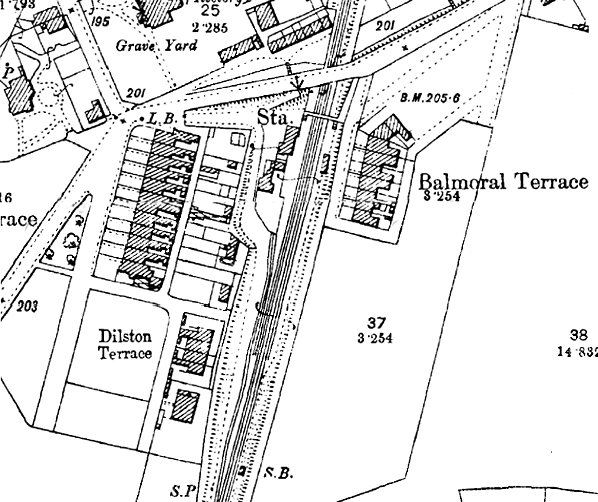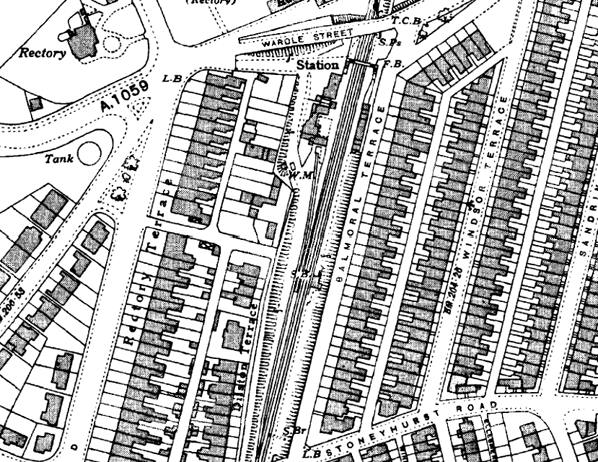Note: Originally called Gosforth, this station opened in 1864 with the Blyth & Tyne’s Newcastle (New Bridge Street) to Backworth line. At that time it was in a semi-rural setting, serving several small communities, such as South Gosforth and Haddrick’s Mill, as well as Gosforth Colliery and its cottages a short distance to the north-east. Gosforth itself was a large village, half-a-mile west on the Great North Road.
 |
The station’s main facilities were on the ‘down’ (west) platform. The station building was constructed of brick in a Tudor Gothic style, described by Fawcett as owing not a little to Brunel’s early stations (such as Culham) and exhibiting three ‘cells’ with roof ridges all in line, but stepping down to different heights either side of the central portion. A cross-gable at the north end thrust forward from the central portion on both the platform and exterior elevations. The booking hall, acting also as a general waiting room, occupied the central section, flanked by an office on its north side, and the Ladies' waiting room on the south side, which incorporated the ladies' toilets. The office included a parcels counter, accessed by the public through its own door from the platform, the ticket window serving into the general waiting room, and the stationmaster's desk, which was at the window at the back of the building, facing the station approach. Narrow |
chimneystacks with crenellated tops, and a slender stone finial on the cross-gable added a note of distinction. An adjoining ridge-roofed timber building with attractive bargeboards housed the gents’ toilet. The stationmaster’s house, in brick but with stone quoins and window dressings, was placed to the south of the main building, but set back behind a small garden. The house was originally a single-storey structure but was increased to two storeys by the NER. Another wooden building, in the same style as the structure which housed the gents’ toilet, stood further south on the platform, used as a porter's room, lamp room and store.
The ‘up’ platform had a lengthy brick single-storey building, largely given over to waiting accommodation. Two cross gables, with dentillation under the eaves, interrupted the frontage, the northern one with a rectangular window, the southern with a circular window and a door. The central section was glazed, and the waiting area was reached through doors with decorated lintels. The north end of the building contained a small booking office with its ticket window opening into the waiting room. The south end of the building housed toilets, reached from the platform. A typical NER iron footbridge was constructed between the platforms at the northern end of the station.
| Fawcett remarks on the generous scale of the facilities in comparison to the earlier B&T stations, which probably reflected the demands of first- and second-class clientele that the company hoped to attract. Even a century after it opened, the station was attractive, with its full range of buildings and well-tended gardens. Its position in a broad cutting, partially screened from |
1.gif) |
neighbouring terraced houses by trees and shrubs, preserved the station’s rural atmosphere.
Shortly before WWI four sidings were in use south of the ‘up’ platform, and reached from the south, whilst a single siding passed behind the southern end of the ‘down’ platform. The station’s signal box stood behind the southern end of the ‘up’ platform, built with an overhang because of the restricted site. Further sidings were situated at Craghall, about ¼-mile south of the station, on the ‘up’ side, and north of the station on the ‘down’ side associated with Gosforth Colliery.
 |
In summer 1896 Gosforth had a service of about a dozen trains each way between Newcastle Central and New Bridge Street via the Coast on weekdays, and nine on Sundays. Trains ran at irregular intervals on weekdays, and surprisingly there was no clear concentration of services at morning and evening rush hours. The first departure for Newcastle direct (New |
Bridge Street) was as late as 8:01am, and there was no earlier train to Newcastle from any station on the line from the coast. Perhaps this reflected the social class of the areas served, with managers and clerks as the customers – who would start work later than workers of lower status. Travelling to or from the northern reaches of the former B&T, eight further trains on weekdays, nine on Saturdays, and four on Sundays called at South Gosforth; the first departure to Newcastle direct was at 8:51 am.
The irregular and infrequent steam trains were replaced, from 29 March 1904, by frequent third-rail electric trains between Newcastle (New Bridge Street) and Benton. The new service was extended in stages via Tynemouth to reach Newcastle Central three months later. Steam trains to and from Newbiggin and Morpeth via Hartley continued to call at South Gosforth.
30-minute intervals: Newcastle Central – Monkseaton – New Bridge Street
30-minute intervals: Newcastle Central – Monkseaton (did not serve Benton)
30-minute intervals: New Bridge Street – Benton
30-minute intervals: Newcastle Central – Riverside – Tynemouth (did not serve Benton)
The Coast Circle route from Newcastle Central to Jesmond, with Manors (North) replacing New Bridge Street, was opened on 1 January 1909, but until 1917 the new link was used only by Newcastle Central – Benton trains.
| On 1 March 1905 the station was renamed South Gosforth, more accurately reflecting the name of the locality which had grown into an outer suburb of Newcastle. However its change of name was to distinguish it from West Gosforth station which opened on 1 June 1905 on the Ponteland Light Railway. This new line left the former B&T route immediately north of |
 |
South Gosforth, curving sharply to the west as the B&T curved sharply east. Although the intention of the NER was to electrify this line, passenger trains were operated by ‘steam autocars’ (push-and-pull sets) making ten daily runs (four on Sundays) between Ponteland and their terminus at South Gosforth. From 1913 the northern destination of these trains was Darras Hall, built as a ‘reverse’ extension to the Ponteland branch. A loop line was installed on the up side south of South Gosforth station where the Darras Hall autocar could stand between services; a water column (which survived into the 1960s) was also provided for its benefit. By the early 1920s the Darras Hall train service was experiencing competition from buses, and passenger bookings declined. Late in that decade Sentinel Steam Cars, running through to Newcastle, were introduced in an unsuccessful attempt to revive the service. The branch to Ponteland and Darras Hall was closed to passengers on 17 June 1929, but it was retained for goods trains.
5.gif) |
In October 1923 the LNER opened car sheds to maintain the electric units. These had been planned, and construction had commenced, during NER administration. This spacious facility was located north of South Gosforth between the Ponteland line and the ex-B&T, where it crossed Killingworth Road. The new building covered ten through lines and two into the |
repair shop. To the north of the car sheds Gosforth Garden Village was built to house the workforce.
In the LNER era ‘mint imperial’ style electric lamps were installed in the station, carried on swan-neck standards. The company’s policy was to provide small nameplates to accompany the electric lamps, which they did at South Gosforth. The LNER also fitted running-in boards of a style believed to be unique to the ‘Coast Circle’ incorporating the company’s early diamond logo. In January 1948 the station became part of the nationalised British Railways North Eastern Region, then in January 1967, when the North Eastern Region was abolished it was transferred to the Eastern Region. The LNER nameboards were in place well into the British Railways era, being replaced with tangerine vitreous enamel boards in about 1960. LNER nameplates were retained until 1971; totem signs were never fitted.
On 9 February 1964 semaphore signalling at the station gave way to colour lights, controlled from Newcastle, so the station signal box was closed.
| The summer 1920 timetable shows trains every half hour throughout the day on weekdays, with a more intensive rush hour service, and an hourly service on Sundays. By the late-1930s this had increased in frequency to 20-minute intervals on weekdays and half-hourly on Sundays. On summer Sundays in the mid 1950s the same frequency was provided, with |
 |
hourly Sunday trains in the winter. The familiar 1937 electric multiple units were eventually condemned as ‘life expired’ by British Rail, and phased out over a two-year period to be replaced with diesel multiple units. The ‘diesel’ timetable was introduced on 6 March 1967; the final emu ran on 17 June 1967. The diesel units provided a slower service, and the longstanding 20-minute frequency of trains was reduced to half-hourly intervals; an express service each hour did not call at the station. Although there was a sense of the Coast Circle line being run down – indeed cynics saw the removal of the electric service as evidence of this – South Gosforth station remained well cared for. New Tynerider branded services – the same old dmus with jolly orange transfers added to them! - were introduced in October 1970 to revitalise the route, and the 20-minute interval service was restored. This continued until the station closed temporarily in January 1978 for the conversion of the route to Metro operation.
 |
Whereas the other eight stations from West Jesmond to Tynemouth which were to become Metro ‘halts’ were sympathetically dealt with, and retain most of their original buildings, South Gosforth was radically changed. The privilege of accommodating the control centre for the Metro network resulted in the demolition of all of the buildings on the down (west) platform, a process which began some months before the station was temporarily closed. (The accompanying photograph, taken on 24 July 1977, shows the construction of the control centre in progress.) The waiting room building on the up platform survived a little longer, but regrettably was also swept away, to be replaced with a standard Metro shelter of little architectural merit. The NER footbridge was retained, looking somewhat incongruous in the company of 1980s structures. Tynesiders can be justly proud of their Metro system, but South Gosforth station lost all of its character in the process. In May 1981 the station regained its status as a junction when the former Ponteland / Darras Hall branch was reopened by the Metro as far as Bank Foot (Kenton). In November 1991 this line was extended to serve Newcastle Airport.
8.gif) |
Gosforth Colliery: From an unknown date until 1955 a miners’ service operated between Hazelrigg Colliery (north of Gosforth) on a mineral line to and from South Gosforth. It is thought that the miners used joined and alighted from trains within the triangle of lines immediately north of South Gosforth, at the site of the former Gosforth Colliery. There is no evidence that |
the trains used South Gosforth station.
Gosforth Sheds: Also close to South Gosforth passenger station, a regular service operated for railwaymen, during World War II, between Gosforth car sheds and Newcastle. It was shown in the working timetable of 11 March 1940.
BRIEF HISTORY OF BLYTH & TYNE RAILWAY (Newcastle [New Bridge Street] – Jesmond – Benton – Backworth)
The southern end of the Blyth & Tyne Railway has a complicated history. Until 1861 there was a single route from Blyth and Seghill onward through Prospect Hill to Percy Main, with a terminus adjacent to the NER station. However in that year a new branch
was opened, following the route of the former Whitley Waggonway, extending from Hartley to Tynemouth. It should be noted that this included the stretch to what is now Monkseaton, which was to be known as the ‘Avenue Branch’, and that the line beyond to Tynemouth was half a mile inland of the present day Monkseaton – Tynemouth Metro line.
At the Tynemouth end the original terminus was quickly replaced with a new one on a short branch which curved south eastwards, and that in turn closed when its branch was extended to a third terminus, which adjoined the 1847 Tynemouth terminus of what had been the Newcastle & North Shields Railway.
In 1864 the Blyth & Tyne reached Newcastle, with a terminus at New Bridge Street. This was achieved by diverting trains onto a new line just south of Holywell, then through Backworth, Benton, and Jesmond. At Backworth a new line was opened to join the 1861 Whitley (Monkseaton) to Tynemouth route. Trains could now travel on the B&T from Newcastle (New
|
9.gif) |
Bridge Street) to Tynemouth, making the Holywell – Prospect Hill – Percy Main route, and the ‘Avenue Branch’ between Hartley and Whitley (Monkseaton) redundant. These two lines closed in June 1864 on the day when the Newcastle – Tynemouth service was inaugurated.
In 1874 the B&T was absorbed by the NER, and the opportunity was taken to reorganise the railway routes in the Monkseaton / Whitley / Tynemouth area. With the growth of housing and holidaymaking on the coast the ‘inland’ route from Monkseaton to North Shields was superseded in 1882 by one within sight of the sea, and the two formerly competing termini at Tynemouth were replaced with a splendid new through station. This created the coastal section of the familiar Coast Circle and Metro route, although there were to be realignments at Whitley Bay in 1910 and Monkseaton in 1915 where new, larger stations were built.
In response to the growth and electrification of street tram networks on North Tyneside the Coast Circle route via both Wallsend and Carville was electrified in 1904 on the third rail system, and the irregular and infrequent steam service was replaced with a frequent interval service. For almost six decades the basic pattern was three trains per hour in each direction, with extras in the rush hour.
10.gif) |
In 1963 the Reshaping of British Railways (‘Beeching’) report made no reference to the main Coast Circle line, but the Riverside Branch, via Carville, was recommended for closure (which was eventually implemented in 1973). However on a visit to Tyneside shortly after the report’s publication Beeching made it clear that the Coast Circle line was a likely |
candidate for closure. In the mid 1960s the ageing electric multiple units, dating from 1937, were being allowed a few more minutes to complete their journeys, and the decision was made to replace them with diesel multiple units cascaded from other areas rather than with newer electric stock. In June 1967, shortly after the line became part of British Rail’s Eastern Region – the North Eastern having been abolished - the last EMUs ran, and the third rails were removed.
 |
The service of three stopping trains per hour in each direction was replaced with a half-hourly service, plus one ‘express’ serving only the coastal stations, Wallsend and Manors; it is no surprise that custom was lost at the stations whose service was cut. However in October 1970 the tide turned, and the Eastern Region launched the vigorous Tynerider campaign to revitalise |
the line (including the Riverside branch) and the South Shields branch. Although the Riverside continued to have a sparse service at rush hours only, the Coast Circle’s 20-minutely service returned, with the new feature of trains in the early hours to bring revellers home from Newcastle city centre. Passenger numbers increased dramatically, and strengthened the case for further investment. The idea of incorporating the local railways into a rapid transit system was examined, and in 1973 Royal Assent was obtained to use the Coast Circle as the basis of such a network, which was to become the Tyne & Wear Metro.
The engineering work to bring about this transformation was ambitious, involving the driving of tunnels under central Newcastle and Gateshead and constructing a sixth bridge over the Tyne between these centres, so that the Metro could be separated from the ‘main line’ system. For some time between January 1978 and November 1982 all of the stations on the Coast Circle (except Tynemouth) were closed for conversion work to be done: this included West Jesmond, South Gosforth, Longbenton, Benton, and West Monkseaton on the former B&T Newcastle route, thus their inclusion in the list of Disused Stations. Backworth closed in 1977 and Manors North in 1978 and were not to reopen on the new Metro line (although Manors underground station replaced Manors North, and Northumberland Park was opened in 2005 immediately south-west of the site of Backworth).
| Almost all of the Newcastle – Backworth route remains as part of the Metro system. Only at the southern end has there been any significant change. A short distance north of the original Jesmond station the Metro route of 1980 curves to the south-west to enter the tunnel beneath central Newcastle and the new |
 |
Jesmond station.
Click here for a list of sources and a Blyth & Tyne bibliography
Tickets from Michael Stewart & Brian Johnson except 7938 CJ Dean and 32166 Alan Young. Timetable from Alan Young. Street map from Ali Ford. Route map drawn by Alan Young.
To see other stations on the Blyth & Tyne Railway Newcastle - Backworth line click on the station name: Newcastle New Bridge Street, Manors North, Jesmond, West Jesmond*, Moor Edge, Longbenton*, Benton (1st site)*,
Benton (2nd site)*, Forest Hall, Benton Square and Backworth (2nd site).
See also Ponteland & Darras Hall branches:
West Gosforth, Coxlodge, Kenton Bank, Callerton, Ponteland, Darras Hall.
* Station reopened as part of the Tyne & Wear metro. Three other Metro stations on this line are new sites and are not included. These are Palmersville, Northumberland Park and Ilford Road. |



gosforth9.jpg)
gosforth10.jpg)


1.gif)



5.gif)


8.gif)
9.gif)
10.gif)





 Home Page
Home Page